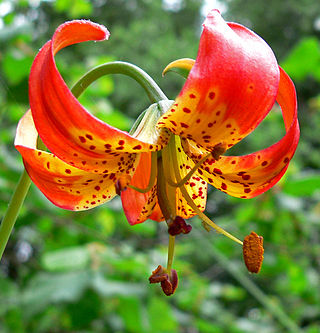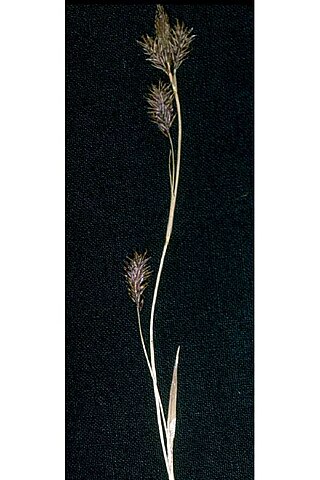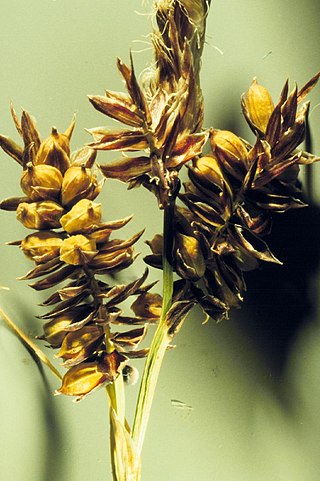
Lilium pardalinum subsp. pitkinense, the Pitkin Marsh lily, is an endangered perennial herb of the family Liliaceae that is endemic to certain wetland areas in the northern California Coast Ranges of Sonoma County, California, United States. It is a subspecies of Lilium pardalinum.

Carex angustata is a species of sedge known by the common name widefruit sedge. It is native to the western United States from Washington and Idaho to California, where it grows in wet meadows and on streambanks.

Carex comosa is a species of sedge known as longhair sedge and bristly sedge. It is native to North America, where it grows in western and eastern regions of Canada and the United States, and parts of Mexico. It grows in wet places, including meadows and many types of wetlands. Tolerates deeper water than most common species and is good for retention basins. This sedge produces clumps of triangular stems up to 100 or 120 centimeters tall from short rhizomes. The inflorescence is up to 35 centimeters long and has a long bract which is longer than the spikes. It is a cluster of several cylindrical spikes. The scales over the fruits taper into long, thin awns.

Carex disperma is a species of sedge known by the common names softleaf sedge or two-seed sedge. It is native to much of the northern Northern Hemisphere, from Alaska to Greenland, most of Canada and the contiguous United States, and across Eurasia.

Carex douglasii is a species of sedge known by the common name Douglas' sedge.

Carex illota is a species of sedge known by the common name sheep sedge. It is native to western North America, where it grows in wet places such as marshes and mountain meadows, from New Mexico and California north to Western Canada.

Carex luzulina is a species of sedge known by the common name woodrush sedge.

Carex lyngbyei is a species of sedge known by the common name Lyngbye's sedge. It is native to the west coast of North America from Alaska to California, where it "is the common sedge of the Pacific coastal salt marshes." It is also known from Greenland and Iceland. It prefers to grow in silty sediment rather than sand and in habitat with brackish water, such as salt marshes. This sedge produces stems 25 centimeters to well over one meter tall from a network of long rhizomes. The leaves have reddish brown sheaths which do not have spots. The inflorescence produces stiff, nodding spikes on peduncles. The fruit is coated in a leathery yellowish brown sac called a perigynium. This is a pioneer species, one of the first plants to colonize the mud of tidal flats in its range.

Carex occidentalis is a species of sedge known by the common name western sedge. It is native to the southwestern United States and parts of the west as far north as Montana. It grows mainly in dry habitat such as woodland and grassland. The plant produces very narrow stems up to about 90 centimeters in maximum height, sometimes with rhizomes. The inflorescence produces a cluster of several rounded flower spikes. The pistillate flowers are covered in scales which are brown with green, three-veined centers.

Carex pansa is a species of sedge known by the common name sand dune sedge. It is native to coast of western North America from British Columbia to California, where it grows in dunes and other sandy habitat. This grasslike sedge produces sharply triangular stems up to about 40 centimeters tall from a network of thin, long, coarse rhizomes. The inflorescence is a cluster of several spikes of dark brownish flowers. The plant sometimes produces only male or female flowers in its inflorescences, but not both. This sedge is sometimes used as a grass substitute in local landscaping schemes.

Carex praeceptorum is a species of sedge known by the common names early sedge and teacher's sedge.

Carex raynoldsii is a species of sedge known by the common name Raynolds' sedge. It is native to western North America and grows in alpine to subalpine meadows.

Carex vernacula is a species of sedge known by the common name native sedge.

Carex pensylvanica is a species of flowering plant in the sedge family commonly called Pennsylvania sedge. Other common names include early sedge, common oak sedge, and yellow sedge.

Carex concinna is a species of sedge known by the common names low northern sedge, northern elegant sedge, beauty sedge, and beautiful sedge. It is native to northern North America, where it occurs across Canada and in high elevations in the northern contiguous United States.

Carex vaginata is a species of sedge known by the common name sheathed sedge.

Carex barrattii is a species of sedge known as Barratt's sedge. It is endemic to the United States, where it occurs on the Atlantic Coastal Plain from Connecticut south to Georgia and Alabama. It also occurs in the southern Appalachians.
Carex oronensis is a species of sedge known by the common name Orono sedge. It is endemic to Maine in the United States, where it occurs mainly in the Penobscot River Valley. It is the only plant that is endemic to the state of Maine. The type locality is Orono.

Carex lacustris, known as lake sedge, is a tufted grass-like perennial of the sedge family (Cyperaceae), native to southern Canada and the northern United States. C. lacustris us an herbaceous surface-piercing plant that grows in water up to 50 cm (1.6 ft) deep, and grows 50–150 cm (1.6–4.9 ft) tall. It grows well in marshes and swampy woods of the boreal forest, along river and lake shores, in ditches, marshes, swamps, and other wetland habitat. It grows on muck, sedge peat, wet sand or silt, in filtered or full sunlight.

Carex eburnea, known as ivory sedge, ebony sedge, and bristleleaf or bristle-leaved sedge, is a small and slender sedge native to North America, from Alaska and Newfoundland south to central Mexico.



















